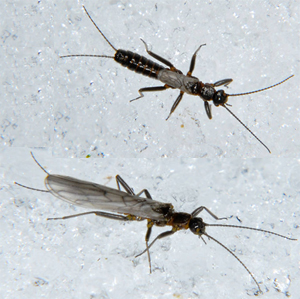(Tiny Black Stone)

Copyright © 2012 Bob Newell
(Widespread Snowfly)
(Slender Snowfly)
(Dwarf Snowfly)
| Home | Map | FAQ | Flyfishing Entomology |
WA Stonefly Description |
| Taxonomic Name (Common Name) | Nymph | Adult |
| Capniidae (Slender Winter Stonefly) | Abdominal terga widest posterially; paraglossa and glossa about equal in length. |
| Bolshecapnia (Tiny Black Stone) | (no photo) | (no photo) |
| Males have a ventral vestigal on 9th sternum and are large in size. | ||
| Bolshecapnia sasquatchi |
| Capnura (Tiny Black Stone) | (no photo) | (no photo) |
| Epiproct is divided into an upper and lower limb, neither laterally divided.. | Males w/ wing shortening; found in small and ephemeral streams draining foothill regions. | |
| Capnura elevata | ||
| Capnura venosa |
| Eucapnopsis (Tiny Black Stone) | (no photo) | adult Copyright © 2011 Brady Richards |
| Eucapnopsis brevicauda |
| Isocapnia (Tiny Black Stone) | (no photo) | (no photo) |
| Have long vertical swimming hairs fringing cerci. | ||
| Isocapnia abbreviata | ||
| Isocapnia agassizi | ||
| Isocapnia grandis | ||
| Isocapnia palousa | ||
| Isocapnia rickeri | ||
| Isocapnia spenceri | ||
| Isocapnia vedderensis |
| Mesocapnia (Tiny Black Stone) | (no photo) | (no photo) |
| Males w/epiproct tip constricted as a narrow spine; females w/nipple on midline of subgenital plate projecting to rear. | Some species have shortened wings, with shortening more noticible in males than females. | |
| Mesocapnia autumna | ||
| Mesocapnia oenone | ||
| Mesocapnia porrecta | ||
| Mesocapnia projecta |
| Paracapnia (Tiny Black Stone) | (no photo) | (no photo) |
| Both adults and nymphs exhibit extreme harriness, even in 1st instar. | Males have thin, tubular epeproct, regularly have shortened wings, while females are usually long-winged. | |
| Paracapnia ensicala |
State of Washington distribution is based on: Valid Stonefly Names for North America.
Created: 08/16/2013 Last modified: 12/08/2014 www.FlyfishingEntomology.com